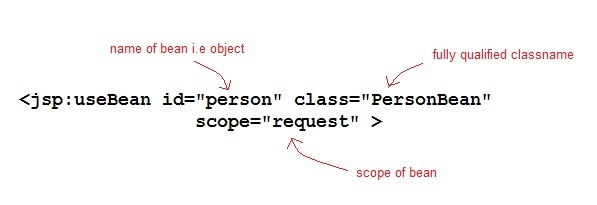jsp:useBean tag in JSP
JSP jsp:useBean Tag
If you want to interact with a JavaBeans component using the Action tag in a JSP page, you must first declare a bean. The <jsp:useBean> is a way of declaring and initializing the actual bean object. By bean we mean JavaBean component object. Syntax of <jsp:useBean> tag<jsp:useBean id = "beanName" class = "className"
scope = "page | request | session | application"> 
<jsp:useBean id="myBean" class="PersonBean" scope="request" />
PersonBean myBean = (PersonBean)request.getAttribute("myBean");
if(myBean == null)
{
myBean = new PersonBean();
request.setAttribute("myBean", myBean);
}
Time for an Example
In this example we will see how<jsp:useBean> standard tag is used to declare and initialize a bean object. We will use PersonBean class as JavaBean Component.PersonBean.java
import java.io.Serializable;
public class PersonBean implements Serializable
{
private String name;
public PersonBean()
{
this.name="";
}
public void setName(String name)
{
this.name = name;
}
public String getName()
{
return name;
}
}
<html>
<head>
<title>Welcome Page</title>
</head>
<jsp:useBean id="person" class="PersonBean" scope="request" />
<body>
//Use the bean here...
</body>
</html>
Comments
Post a Comment